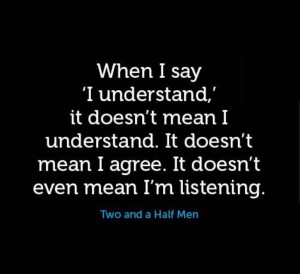 We’ve noticed a consistent gap in workplace conversations. To convey understanding, most people use easy phrases like “I understand,” “I appreciate that,” or “I get it,” and often say these phrases repeatedly in an effort to show that they indeed understand. Few go so far as to offer a brief re-cap by saying something like, “Okay, if I’m tracking, you’re saying…”, and then asking if their re-cap is on target. Why bother with the extra effort? Well, maybe you think you understand, but in reality you don’t fully grasp what the other is saying. Or maybe the other person can’t find the right words and could use your help finding them. By 1) re-capping what you think the other person is saying, 2) asking him or her if you’ve got it right, 3) repeating these first two steps if necessary, and 4) ultimately getting an affirmative response, you’re showing that you understand. This practice is particularly important when others have been talking for a while, and especially if they’ve been repeating themselves. While it may seem unnecessary to check your understanding when others have been repeating themselves (“Hey, dude, I get it!”), this is exactly when checking may be the most helpful. Why? Because repetition is often a signal that the other person doesn’t feel heard, or believes you’re missing their point. Paraphrasing and getting confirmation usually ends the repetition because now you’ve shown that you understand, and the other person sees that further repetition isn’t needed. So our recommendation is simple: If the conversation is important and your goal is to understand others and have them feel understood, show that you understand first. Don’t just say you do.
We’ve noticed a consistent gap in workplace conversations. To convey understanding, most people use easy phrases like “I understand,” “I appreciate that,” or “I get it,” and often say these phrases repeatedly in an effort to show that they indeed understand. Few go so far as to offer a brief re-cap by saying something like, “Okay, if I’m tracking, you’re saying…”, and then asking if their re-cap is on target. Why bother with the extra effort? Well, maybe you think you understand, but in reality you don’t fully grasp what the other is saying. Or maybe the other person can’t find the right words and could use your help finding them. By 1) re-capping what you think the other person is saying, 2) asking him or her if you’ve got it right, 3) repeating these first two steps if necessary, and 4) ultimately getting an affirmative response, you’re showing that you understand. This practice is particularly important when others have been talking for a while, and especially if they’ve been repeating themselves. While it may seem unnecessary to check your understanding when others have been repeating themselves (“Hey, dude, I get it!”), this is exactly when checking may be the most helpful. Why? Because repetition is often a signal that the other person doesn’t feel heard, or believes you’re missing their point. Paraphrasing and getting confirmation usually ends the repetition because now you’ve shown that you understand, and the other person sees that further repetition isn’t needed. So our recommendation is simple: If the conversation is important and your goal is to understand others and have them feel understood, show that you understand first. Don’t just say you do.
April 2020
Leave a Reply
Leave a Reply
You must be logged in to post a comment.
About the author